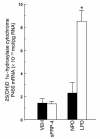Secreted frizzled-related protein 4 is a potent tumor-derived phosphaturic agent
- PMID: 12952927
- PMCID: PMC182208
- DOI: 10.1172/JCI18563
Secreted frizzled-related protein 4 is a potent tumor-derived phosphaturic agent
Abstract
Tumors associated with osteomalacia elaborate the novel factor(s), phosphatonin(s), which causes phosphaturia and hypophosphatemia by cAMP-independent pathways. We show that secreted frizzled-related protein-4 (sFRP-4), a protein highly expressed in such tumors, is a circulating phosphaturic factor that antagonizes renal Wnt-signaling. In cultured opossum renal epithelial cells, sFRP-4 specifically inhibited sodium-dependent phosphate transport. Infusions of sFRP-4 in normal rats over 2 hours specifically increased renal fractional excretion of inorganic phosphate (FEPi) from 14% +/- 2% to 34% +/- 5% (mean +/- SEM, P < 0.01). Urinary cAMP and calcium excretion were unchanged. In thyro-parathyroidectomized rats, sFRP-4 increased FEPi from 0.7% +/- 0.2% to 3.8% +/- 1.2% (P < 0.05), demonstrating that sFRP-4 inhibits renal inorganic phosphate reabsorption by PTH-independent mechanisms. Administration of sFRP-4 to intact rats over 8 hours increased FEPi, decreased serum phosphate (1.95 +/- 0.1 to 1.53 +/- 0.09 mmol/l, P < 0.05) but did not alter serum 1alpha, 25-dihydroxyvitamin D, renal 25-hydroxyvitamin D 1alpha-hydroxylase cytochrome P450, and sodium-phosphate cotransporter mRNA concentrations. Infusion of sFRP-4 antagonizes Wnt action as demonstrated by reduced renal beta-catenin and increased phosphorylated beta-catenin concentrations. The sFRP-4 is detectable in normal human serum and in the serum of a patient with tumor-induced osteomalacia. Thus, sFRP-4 displays phosphatonin-like properties, because it is a circulating protein that promotes phosphaturia and hypophosphatemia and blunts compensatory increases in 1alpha, 25-dihydroxyvitamin D.
Figures





Comment in
-
Evidence for a bone-kidney axis regulating phosphate homeostasis.J Clin Invest. 2003 Sep;112(5):642-6. doi: 10.1172/JCI19687. J Clin Invest. 2003. PMID: 12952909 Free PMC article.
Similar articles
-
The phosphatonins and the regulation of phosphate transport and vitamin D metabolism.J Steroid Biochem Mol Biol. 2007 Mar;103(3-5):497-503. doi: 10.1016/j.jsbmb.2006.11.010. Epub 2007 Jan 16. J Steroid Biochem Mol Biol. 2007. PMID: 17224271
-
Secreted frizzled-related protein-4 reduces sodium-phosphate co-transporter abundance and activity in proximal tubule cells.Pflugers Arch. 2006 Jan;451(4):579-87. doi: 10.1007/s00424-005-1495-2. Epub 2005 Sep 9. Pflugers Arch. 2006. PMID: 16151791
-
Renal expression of the sodium/phosphate cotransporter gene, Npt2, is not required for regulation of renal 1 alpha-hydroxylase by phosphate.Endocrinology. 2001 Mar;142(3):1124-9. doi: 10.1210/endo.142.3.8029. Endocrinology. 2001. PMID: 11181527
-
Phosphatonins and the regulation of phosphate homeostasis.Annu Rev Physiol. 2007;69:341-59. doi: 10.1146/annurev.physiol.69.040705.141729. Annu Rev Physiol. 2007. PMID: 17002592 Review.
-
New insights into phosphate homeostasis: fibroblast growth factor 23 and frizzled-related protein-4 are phosphaturic factors derived from tumors associated with osteomalacia.Curr Opin Nephrol Hypertens. 2002 Sep;11(5):547-53. doi: 10.1097/00041552-200209000-00011. Curr Opin Nephrol Hypertens. 2002. PMID: 12187320 Review.
Cited by
-
MEPE has the properties of an osteoblastic phosphatonin and minhibin.Bone. 2004 Feb;34(2):303-19. doi: 10.1016/j.bone.2003.10.005. Bone. 2004. PMID: 14962809 Free PMC article.
-
Osteoblast autonomous Pi regulation via Pit1 plays a role in bone mineralization.Mol Cell Biol. 2007 Jun;27(12):4465-74. doi: 10.1128/MCB.00104-07. Epub 2007 Apr 16. Mol Cell Biol. 2007. PMID: 17438129 Free PMC article.
-
Novel regulators of Fgf23 expression and mineralization in Hyp bone.Mol Endocrinol. 2009 Sep;23(9):1505-18. doi: 10.1210/me.2009-0085. Epub 2009 Jun 25. Mol Endocrinol. 2009. PMID: 19556340 Free PMC article.
-
Diagnostic Modalities for FGF23-Producing Tumors in Patients with Tumor-Induced Osteomalacia.Endocrinol Metab (Seoul). 2014 Jun;29(2):136-43. doi: 10.3803/EnM.2014.29.2.136. Endocrinol Metab (Seoul). 2014. PMID: 25031885 Free PMC article. Review.
-
Case Report: Phosphaturic mesenchymal tumor presenting solely as knee pain without hypophosphatemia.Front Oncol. 2025 May 8;15:1597194. doi: 10.3389/fonc.2025.1597194. eCollection 2025. Front Oncol. 2025. PMID: 40406261 Free PMC article.
References
-
- Aschinberg LC, Solomon LM, Zeis PM, Justice P, Rosenthal IM. Vitamin D-resistant rickets associated with epidermal nevus syndrome: demonstration of a phosphaturic substance in the dermal lesions. J. Pediatr. 1977;91:56–60. - PubMed
-
- Cai Q, et al. Brief report: inhibition of renal phosphate transport by a tumor product in a patient with oncogenic osteomalacia. N. Engl. J. Med. 1994;330:1645–1649. - PubMed
-
- Kumar R. Tumor-induced osteomalacia and the regulation of phosphate homeostasis. Bone. 2000;27:333–338. - PubMed
-
- Kumar R. Phosphatonin—a new phosphaturetic hormone? (lessons from tumour-induced osteomalacia and X-linked hypophosphataemia) Nephrol. Dial. Transplant. 1997;12:11–13. - PubMed
-
- Kumar R. New insights into phosphate homeostasis: fibroblast growth factor 23 and frizzled-related protein-4 are phosphaturic factors derived from tumors associated with osteomalacia. Curr. Opin. Nephrol. Hypertens. 2002;11:547–553. - PubMed
Publication types
MeSH terms
Substances
Grants and funding
LinkOut - more resources
Full Text Sources
Other Literature Sources
Medical
Molecular Biology Databases

